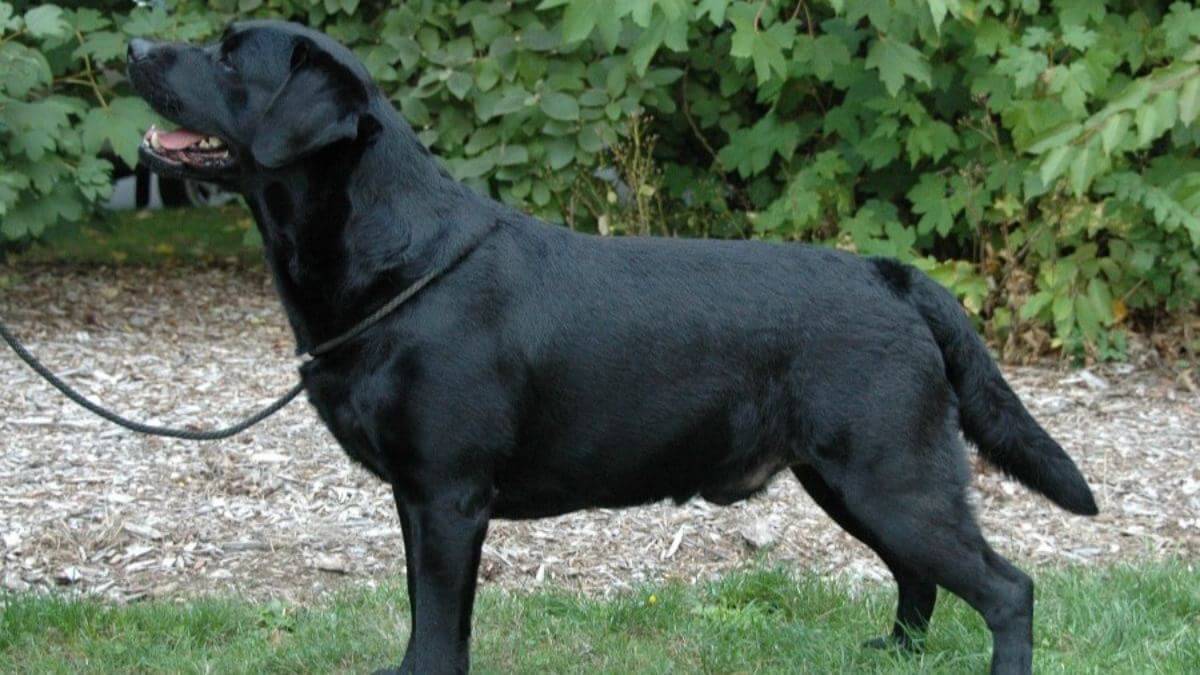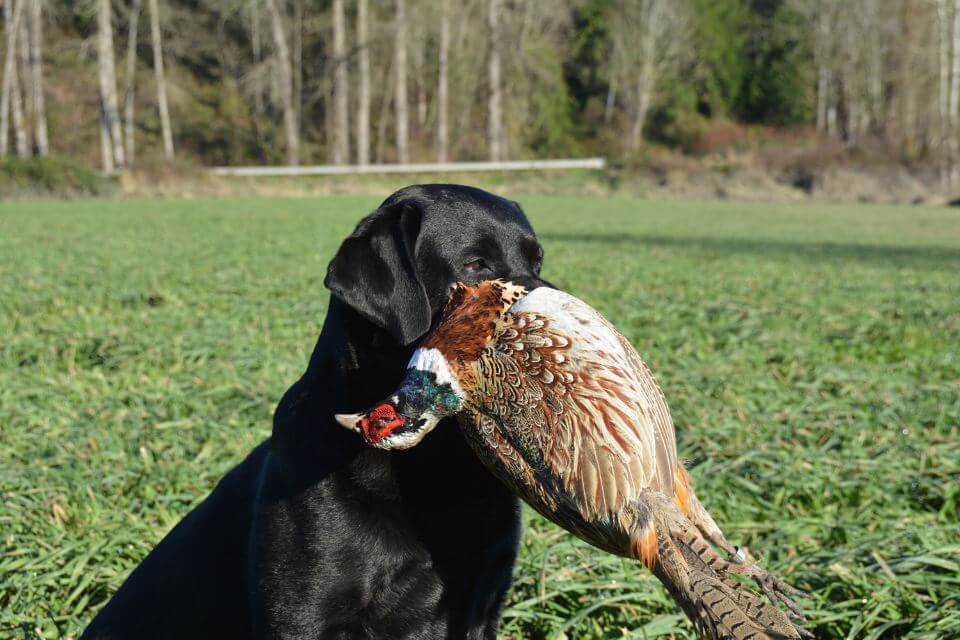


Home » The Labrador Retriever

This article was originally published in Showsight Magazine, November 2019 issue.
The Labrador Retriever is the most popular dog in the United States, where it has maintained its popularity as number one in registration for the past 20 years. This is certainly due to their phenomenal temperament and trainability, which allows the Labrador unusual versatility. The breed dates back to at least the 1830s when it was introduced from ships trading between the Labrador region of Canada and Poole in Dorchester. Early fans of the breed include the Earl of Malmesbury, the Duke of Buccleuch, the Earl of Home, and Sir John Scott.
At first, the dogs were not referred to as Labradors. The first Labrador was described as not being larger than the English Pointer, more often black than other colors, long in its head and nose, with a deep chest, fine legs, a short and smooth coat, and did not carry its tail as highly as the Newfoundland. In 1887, the Earl of Malmesbury wrote a letter: “We have always called mine Labrador dogs and I have kept mine as pure as I could from the first that I had from Poole.”
There is a stud book of the Duke of Buccleuch’s Labrador Retrievers which makes it possible to work out pedigrees of the two dogs that contributed most to produce today’s Labradors. The Labrador was first recognized as a separate breed by the English Kennel Club in 1903. The American Kennel Club registered its first Labrador Retriever in 1918, Brocklehurst Nell, who was imported from Scotland.
The first yellow Labrador on record was born in 1899 (Ben of Hyde). Chocolate Labrador Retrievers appeared in the late 1800s, with brown puppies documented at Buccleuch kennels in 1892.
From the Labrador Breed Standard, the essence of the breed can be described as follows:
The Labrador Retriever is a strongly built, medium-sized, short-coupled dog possessing a sound, athletic, well-balanced conformation that enables it to function as a retrieving gun dog. It has the substance and soundness to hunt waterfowl or upland game for long hours under difficult conditions, the character and quality to win in the show ring, and the temperament to be a family companion.
Physical features and mental characteristics should denote a dog bred to perform as an efficient Retriever of game, with a stable temperament suitable for a variety of pursuits beyond the hunting environment. The most distinguishing characteristics of the Labrador Retriever are its short, dense weather-resistant coat, an “otter” tail, a clean-cut head with a broad back skull and moderate stop, powerful jaws, and its “kind” friendly eye, expressing character, intelligence, and good temperament.
Above all, a Labrador Retriever must be well-balanced, enabling it to move in the show ring or work in the field with little or no effort. The typical Labrador possesses style and quality without over-refinement and substance without lumbering or cloddiness. The Labrador is bred primarily as a working gun dog; structure and soundness are of great importance.
It is inappropriate to judge Labradors strictly on the ever-nuanced idea of type. Movement is a critical element of the Labrador Retriever, given the emphasis in the Labrador standard on structure and soundness. There are differences in the breed standard from country to country. In the United States, as in many other Sporting breeds, there has been a divergence in physical appearance and in energies and aptitudes.

Conformation Labradors, or as John Q Public identifies them, “British” Labradors, tend to be bulkier and stockier, with broader heads, heavier coats, big otter tails, and calmer dispositions. Our conformation-bred dogs need to be differentiated from the British field dog, which is an additional style heavily marketed in the United States. These dogs are smaller than their US counterparts and tend to have longer bodies, longer muzzles, and very slick coats. These dogs are famed for their natural hunting skill and low energy as family pets.
Our “American” Labradors, i.e., dogs from field and performance pedigrees, tend to be lankier, lighter-framed, longer-muzzled, and often do not have the classic “otter” tail. These American dogs have tremendous intelligence and stamina, a great work ethic, and great courage. They tend to have more energy than the typical conformation-bred dog.
It has been many years since the last Dual Champions, i.e., a dog that is both a Show Champion and a Field Champion. The differences seen today in our Labradors make it very unlikely we will see one again.
In the United Kingdom, dogs bred for hunting and field trial work are selected first for working ability, whereas the conformation dogs are selected for their conformation to the standard and other characteristics sought by show judges. A similar selection process occurs in the Labrador in the United States, although the purpose of a Breed Standard is to select for breeding animals and for dogs that embody the breed’s function.
The Labrador Retriever is pleasant, outgoing, and tractable, enabling it to serve the public in a multitude of venues. They are excellent family dogs that are trainable and need training. They generally love children. Labradors do shed, and it may be wise to match the coat color of your dog to the colors in your home.
Labradors are the most commonly used breed as guide dogs for the blind, and they excel as assistance dogs and therapy dogs. Labrador guide dogs have successfully guided their charges to safety in extreme situations. These dogs also work successfully as detection dogs and tracking dogs, both for the military and police forces, where a strong, indefatigable retrieve drive is needed. The Labrador Retriever has served the U.S. as military working dogs in multiple arenas.
Labradors are powerful and enthusiastic swimmers that can tolerate cold water. They are capable of remaining quiet, marking falls, and retrieving both dead and wounded birds. Many are also outstanding upland retrievers who work in the field and are eligible to compete in AKC Hunting Tests and AKC Upland Tests for Retrievers.
The Labrador Retriever is overall a healthy breed. The CHIC requirements for the breed are OFA hips, OFA elbows, OFA eyes, EIC testing, and testing for the dilute gene. Recommended additional tests include the prcd PRA test, cardiac testing, and CNM testing. While other testing is available, the tests should be selected based on Parent Club and veterinary advice.
The breed deserves the popularity it has attained, and it is the mission of breeders to maintain the qualities that make them the most desirable dog in the United States.
#80 CH Briarwood’s Jumpin Jack Black Flash MH (bm, 2018)
CH Bidwell To Hiddensprings Covey Buster MH (bf, 2018)
CH Mar-Jo’s Major Attitude MH CGC (bf, 2018)
CH Wiscoy’s Carnival MH (bf, 2018)
CH Pathways Tygrrsaurus Rex Of Fair Haven MH WCX CGC (ym, 2017)
GCH Seawind Fergmar Bells and Whistles MH UDX OM1 BN (ym, 2017).
The ONLY GCH, MH, UDX Labrador Retriever in the world!!
GCH CH Boynes Avian Investigator MH (bf, 2016)
CH Falline Telemark CD, RN, MH (yf, 2016)
CH Rockycreeks Jack Daniels CD PCD BN RN MH (bm)
CH Duckback Armbrook’s Indigo CD MH (bm)
GCH CH Watersedge John Quincy Adams MH SHU CGC (bm)
CH Cedarwood’s Rollickin’ Good Thyme CD BN RE MH (cf, 2015)
CH B And M Meinhold Col. Hawker RN MH CGC (ym)
CH Klassic’s High Voltage F-18 MH (bm)
CH Oasis Diamond Del Rio MH (yf)
CH Deep Run Casablanca MH (ym)
CH Spirithawk Let It Ride MH (yf)
CH Mar-Jo’s Rough-N-Ready MH (ym)
CH Wiscoys Midnight Train MH (bm)
CH Kohlercreek Radiance At Honorbright MH (yf, 2013)
CH Briarwood’s Luna Brillante MH (yf)
CH Grampian Bedizened Viking RA MH (bf)
CH Briarglen’s Celtic Caper MH (yf)
Am/Can CH ReiMur Juz Fulla Myself CDX RE MH CGC (bm)
CH Sonlight’s Nachusa Storm Chaser MH (yf)
CH Topwater Hiddenspring Yuletide RN MH (bd)
GCH CH Lobuff Major Yeager At Asquam MH (yd)
CH Seawind’s Fergmar Edubard UD OM1 MH (bm)
GCH Am/Can CH Poplar Forest Topp Gunn MH (bm)
GCH Viking Hil’Die Tanzbarin CD RA MH (yf)
CH Nachusa’s I Walk The Line MH (ym)
CH Dickendall Buckstone Deck The Halls MH (bm)
CH Kerrybrook’s Vince MH (ym)
CH Yellow Roses Rio Bravo MH (bm)
CH Hollyhill Password To Bidwell MH (bf)
CH Raintree Wooly Bully RN MH (bm)
GCH CH Hidden Springs Blue Goose MH (ym)
Am/Can CH Poplar Forest Play It Again Sam UD RE MH (bm)
CH Ridge View No Fear MH (ym)
CH Lands End Whatever She Wants CDX RN MH (bf)
CH Caer Bren Superhero CD RN MH (ym)
CH Ransom’s I Wanna Be Good CD MH (bm)
Am/Can Ch. Lor-Al’s Got Our Power Play CD MH (bm)
CH Ransom Armbrook’s Hole In One CD MH (bm)
CH Pembroke Blk Mist Poplar Forest MH (bf)
CH Ransom’s Armbrook Indigo Hue CD MH (bm)
CH Bayview’s Aliho Denali MH (bm)
Am/Can Ch. Fawnhaven Hard Act To Follow CD MH (bm)
CH Waterbound Locke On Laddy MH (bm)
CH Sundance’s Paddy’s Irish Cream CD MH (ym)
CH Danikk Leap of Faith MH (ym)
CH Belle Tradition O’Broad Reach MH (bm)
CH Marit’s Slippry Round the Bend MH (bm)
CH/MACH Prospect’s Slam Dunk UD MH RN MXP5 MJP5 PAX (ym, 2002)
CH Winnie’s Block Buster MH (ym)
CH Ashridge Captain Wentworth MH (ym)
CH Naiken Indian Temple MH (cm)
CH Campbelcroft Peppermint Paddy CDX MH (ym)
CH Ashway’s Willcare Impression CD MH (cm)
CH Bayside’s Mark West CD MH (bm, 2000)
CH Avalon’s Regal Buck MH (bm)
Am/Can Ch. Clarion’s Bad As I Wanna Be CD MH CKC MH (bm)
CH Westwind’s Chilkoot Charlie MH (ym)
CH Brandywine’s Westdale Duggan MH (ym)
CH Franklin’s Pickpocket for Kerrybrook MH (ym, 1999)
Am/Can. Ch. Brookland’s Mischievous Sealion MH CDX NA (ym)
CH Ruthless Blazing Brentley CDX MH (cm)
CH Aliho’s Igloo Iggy UDX MH (ym)
Am/Mex/Int’l Ch. Cook’s Midnight Bandit MH (bm)
CH Topform’s Edward MH (bm, 1995)
CH Willcare’s Gypsy Talkeetna CD MH (ym)
CH Willcare’s Gypsy Chitina CD MH (yf)
CH Devon’s Rough Magic CD TDX MH (bf)
CH Harbortop’s Redwick Valhalla MH (bm, 1993)
CH Broad Reach Gripper UD MH (bf)
CH Duckback’s HiHope CD MH (yf)
CH Plantiers Ruthless Ruthie MH CD (cf)
CH Broad Reach’s Trace Of Grace MH (bf, 1991)
CH Buddy of Cedar Bush Creek UD MH (bm, 1989)
CH Simerdown Royal Canuck MH (ym)
CH Romany Sun Jester CD MH (ym, 1988)